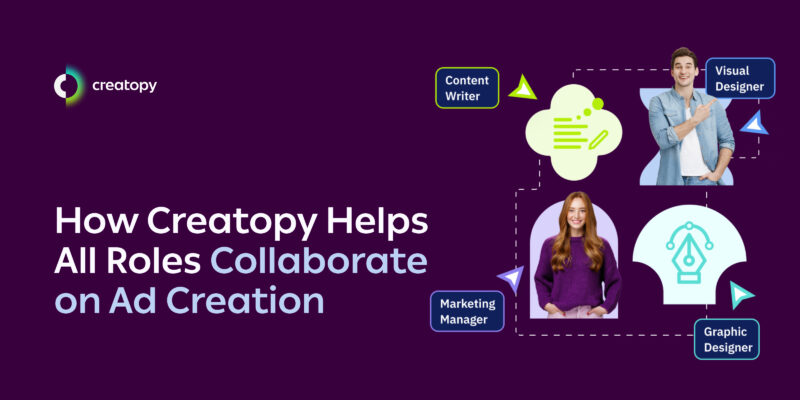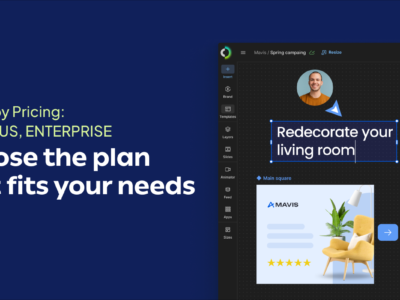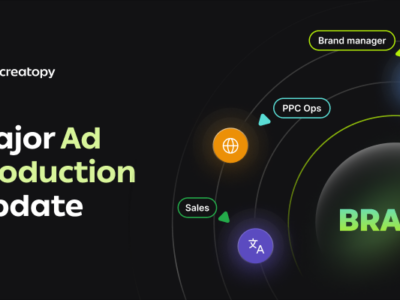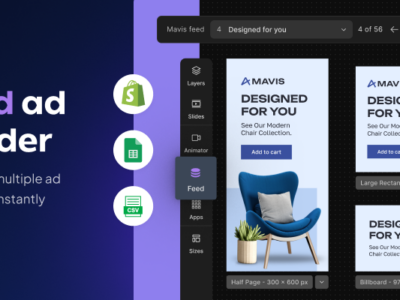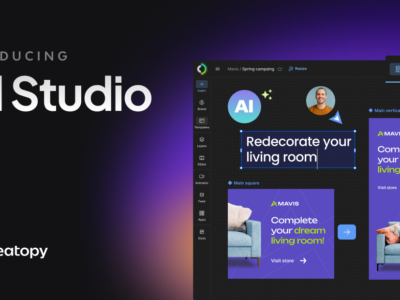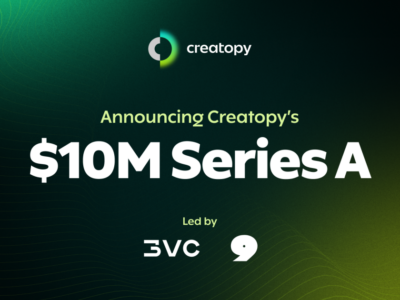Ad creation is no longer what it once was now that time is of the essence.
Only a couple of years back, marketers and designers had the luxury of spending weeks perfecting their marketing campaigns, manually handcrafting dozens of ad variations using siloed workflows.
But times have changed, and this drawn-out approach is no longer feasible.
Businesses that want to stay top-of-mind for customers must produce more visual assets, faster—a nearly impossible feat when working with waterfall-type processes.
If this struggle sounds familiar and rapid, on-brand ad creation is a hassle, we have just the solution for you. Creatopy’s AI-powered ad automation platform comes with a new set of features specifically created to solve this issue.
But before we dive into these, let’s first explore why and how the advertising space changed to better understand why a new approach to digital ad asset creation is needed.
Table of contents
- Changes in the digital advertising space
- Why marketers are struggling to keep up
- Using AI to automate ad creation
- Introducing Creatopy’s new experience
Changes in the digital advertising space
In 2009, users spent approximately 11 minutes per day on social media, according to Nielsen. Fast forward to 2025, and this number has skyrocketed to two hours and 21 minutes daily, as per DataReportal’s findings.
But it’s not just the amount of time spent on social media that increased. The number of channels customers frequent has as well. Today, the typical social media user engages with around seven platforms each month.
That’s seven distinct touchpoints spread across more than 10% of a user’s day.
Despite these changes seemingly presenting more opportunities for connecting, influencing, and converting customers, this isn’t as easy as it sounds. Advertisers can’t just create and launch a one-size-fits-all advertising campaign across all platforms. Each platform has different ad format requirements, size specifications, and audience expectations.
“Data shows effectiveness builds as more channels and touchpoints are layered in but brands and their agencies need to ensure everything is served up in a co-ordinated way.”
— Grace Kite, UK Vice President of Analytic Partners
This is why success in the modern marketing space involves 10-20 times more ad creatives than just a few years ago. And we’re not talking about any marketing creatives, but hyper-relevant ones that are produced with speed and precision.
Why marketers are struggling to keep up
So we’ve established that advertisers need to create and publish more ads. But what’s the big blocker? Why can’t businesses just scale their advertising output or expand their teams in line with this demand?
Well, the answer is as simple as it is complex, as most marketing teams face pressures from at least two separate angles.
Firstly, post-pandemic budget cuts are still an issue, with CMOs dubbing this period the “era of less.” In 2024, Gartner found that marketing budgets had fallen to 7.7% of overall company revenue. This effectively acts as a restraint against expanding marketing teams, meaning companies must do what they can with what they currently have.

Then comes the second issue: outdated creative workflows. These manual-heavy and step-by-step processes rely on siloed collaboration and little-to-no automation. Typically, this looks like:
Marketers draft a brief → wait for designers to interpret it → wait again for visuals → request changes → wait for revisions.
At first glance, this seems straightforward. You may even be scratching your head, wondering what the problem is. And to some extent, you’re right to do so: This process would’ve been spotless a decade ago.
The issue? It wasn’t built for today’s volume and velocity.
Now that businesses need to create many ad variants—think different sizes, CTAs, visuals—the loop needs to restart over and over again. And for campaigns needing dozens of outputs, this can delay timelines and bring about a loss of momentum.
Couple this with misalignment between creatives and marketers—with only 36% of creatives claiming they receive high-quality feedback and 55% of marketers believing their input to be useful—and you’re almost guaranteed an unimpactful advertising campaign.
Using AI to automate ad creation
Now that we’ve established the problem, let’s switch gears and focus on the solution: AI-powered creative workflows.
If you’re reading this, you’re likely no stranger to artificial intelligence. And its impact on content creation hasn’t gone unnoticed:
- 84% of marketers state that AI has improved their speed of high-quality content delivery
- Generative AI saved marketers over three hours on each asset produced
- 43% of marketers use AI to automate repetitive tasks and processes
So how exactly do AI and automation support ad creation? Well, at Creatopy, we have a wealth of AI-powered editing and design features focused on all things ad creation:
- Automated ad variations: Generate multiple ad versions for different formats or use a URL to create a complete branded set instantly.
- Smart resizing: Adapt existing ads to multiple sizes while keeping visuals and brand elements consistent.
- Content personalization: Serve dynamic ad content based on location, audience, or live product data.
- Real-time collaboration: Comment directly on designs and streamline handoffs between teams.
- Live data: Connect real-time data with feeds or APIs to showcase pricing or stock updates, keeping ads relevant and high-performing.
- AI image generation: Create visuals using text prompts or by uploading an existing image as a reference.
- AI image editing: Enhance images with powerful AI editing tools that let you remove or blur backgrounds, generate new ones, erase unwanted objects, and upscale low-resolution images.
- AI translate: Instantly translate ad copy into multiple languages while preserving tone and intent.
- AI copywriting: Generate ad copy like headlines, CTAs, and descriptions tailored to the platform, audience, or campaign goal.
With these AI features, you no longer have to choose between speed and quality. AI gives you the agility, automation, and alignment needed to help you overcome the bottlenecks that burden traditional design workflows.
Not only that, but operational friction is also squashed. You can satisfy the rising demand for content without burdening teams or disproportionally blowing up budgets.
See how Creatopy’s AI-powered design features work in practice.

Introducing Creatopy’s new experience
At Creatopy, we don’t just want to make ad creation easy for advertisers. We want to make the entire creative process a breeze for everyone involved—from marketers and advertisers to designers and beyond.
This is why we’ve upleveled our AI-powered ad campaign automation platform with entirely new experiences so designers and non-designers alike can collaborate on visual assets, unbounded by their design expertise.
Here’s how:
- Brand Kits
- Generative flows
- Light Editor
- Templating system and permissions
Brand Kits
Empower all team members toward on-brand creation with Creatopy’s in-built Brand Kit. Custom-fit to centralize all your brand assets—logos, fonts, color palettes, imagery—designers and non-designers can use it as a springboard for branded ad creation.
But beyond visuals, Creatopy’s Brand Kits can automatically suggest and apply your brand’s tone of voice to ad copy and even enhance your color palette for better visual harmony. This makes it easier than ever to stay consistent, creative, and on-brand at scale.
And just like that, with one click, you can turn a non-branded visual into a branded one without having to double-check your brand style guide.
Generative flows
Make the most of your creativity—or lack thereof—by relying on Creatopy’s generative flows for intuitive creation. No matter your starting point, these three generative flows make on-brand ad creation easier than you could’ve imagined:
- Start from a template: Browse a wide range of ready-made templates—either from Creatopy’s template library or your own branded templates—and customize them while retaining your brand’s look and feel.
- Start from an asset: Use any approved brand image, logo, or media asset as a springboard for a new advert. Best for when you already have something great to use as a base.
- Start from a URL: Let our AI scan and extract data from any URL—such as a product or landing page—to generate on-brand ads instantly without you having to lift a finger.
Light Editor
No design skills? No problem. Creatopy’s Light Editor is a simplified and intuitive design interface built for non-designers. Created with ease of use and speed in mind, non-designers can use it to make quick edits to pre-approved templates. That is, update text, swap images, or resize assets without needing complex design tools.
Its customizable editing controls also preserve brand consistency while making it easy to execute last-minute changes or campaign tweaks—bottleneck-free and without any steep learning curves required.
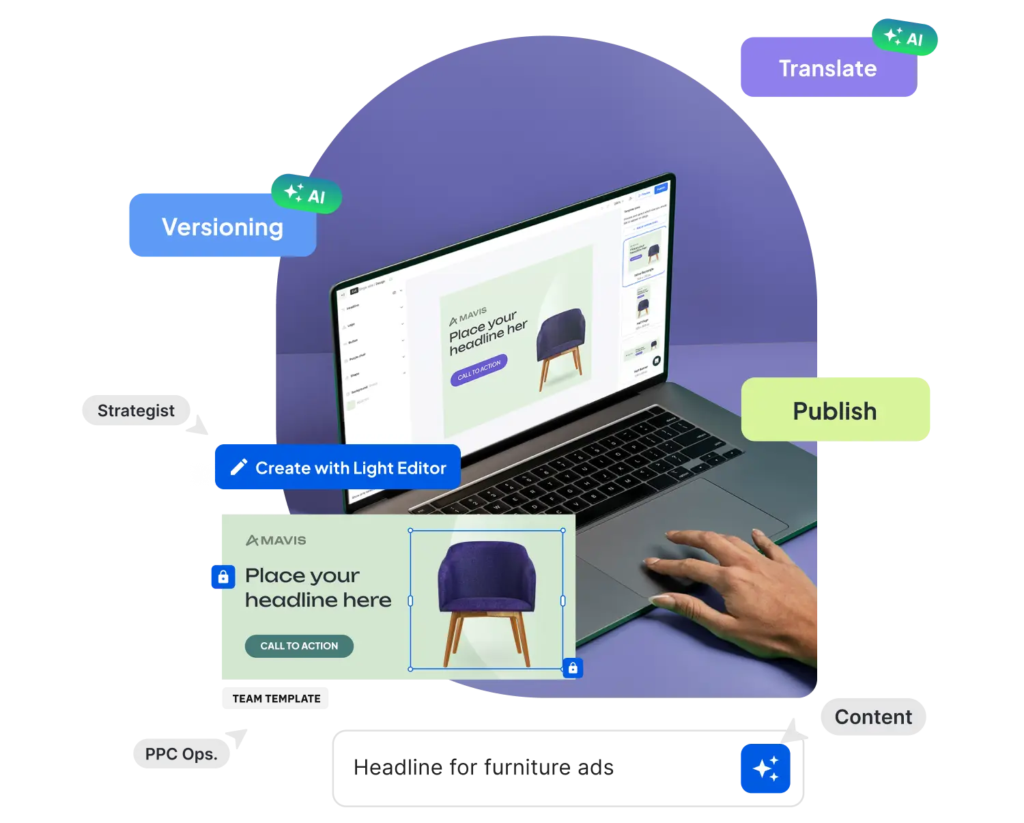
Templating system and permissions
Creatopy’s advanced templating system puts brand control in the hands of designers while giving other team members the flexibility they need during creation.
With set roles and granular layer permissions, designers can lock core brand elements—like logos, colors, and fonts—while enabling editable fields for aspects like copy, images, or layout positioning for non-designers. Non-designers can then personalize ads without accidentally going off-brand. This makes collaboration easier by ensuring each team member can contribute while staying in their own lane.
Here’s a brief overview of the different roles and permissions in Creatopy:
- Team Owner: Has full control over the team as well as billing, branding, roles, and deletion rights.
- Admin: Manages projects, users, and Brand Kits without access to billing or team deletion.
- Template Designer: Creates reusable, on-brand templates and designs.
- Designer: Produces and edits creative assets without admin or template access.
- Content Editor: Edits content using the Light Editor—perfect for those without professional design capabilities, such as marketers and copywriters.
- Viewer: Can view and comment on designs without making any edits or changes.
Stay ahead of trends and competition with Creatopy
Creatopy takes designers out of their isolated creative process by placing key stakeholders at the heart of ad creation. Whether you’re a designer, a marketer, or another cross-functional contributor, Creatopy holds space for your creative expertise without compromising creativity or brand control.
Not only does this ease the workload on designers, but non-designers can now own parts of the design process, enabling them to wrap up projects faster within a collaborative creative environment.
Ready to take your ad design company-wide? Experience Creatopy’s new features with a free trial right away!

